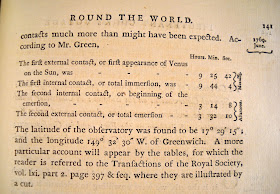 The Green is set up for Commencement--covered with chairs, the stage and bleachers--but on Tuesday a crowd gathered on the grass to watch the last transit of Venus to occur this century. Venus won’t pass directly between the earth and the sun again until the year 2117. Surely Dartmouth students will be here to watch that one as well.
The Green is set up for Commencement--covered with chairs, the stage and bleachers--but on Tuesday a crowd gathered on the grass to watch the last transit of Venus to occur this century. Venus won’t pass directly between the earth and the sun again until the year 2117. Surely Dartmouth students will be here to watch that one as well.The 1769 transit of Venus provided the impetus for Captain James Cook's first voyage around the world. Cook was instructed to observe the transit from Tahiti; a precise measurement of the time it took for Venus to pass across the face of the sun would allow astronomers to calculate the distance between the sun and the earth.
Cook’s observations of the transit of Venus were less accurate than the Royal Society had hoped, but his exploration of Australia and successful circumnavigation of New Zealand made him a national hero. The journals of his first voyage were published in 1773 under the title: An Account of the Voyages Undertaken by the Order of His Present Majesty for Making Discoveries in the Southern Hemisphere (London: W. Strahan and T. Cadell, 1773).
This large, three-volume account of Cook’s voyage was published with the general public in mind; readers interested in the particulars of Cook’s observations were directed to the Transactions of the Royal Philosophical Society. We’re fairly certain our copy once belonged to an armchair traveler -- it still carries a faint scent of tobacco.
See Cook’s observations for yourself by asking for Val G12 H313ac.

No comments:
Post a Comment